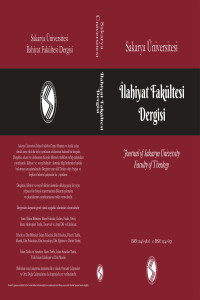Abstract
The author of the book, Hüseyin Zamur, who deals with the issue of isrāʾīliyyāt in the Shīʿīte tafsīr tradition, made an evaluation specifically about the first seven centuries. In the first chapter, he draws a general picture of the reasons for Isrāʾīliyyāt's transition to Islamic sources, then tries to portray how the issue is seen from the Shīʿa perspective. In the second part, the author evaluates the isrāʾīlī narrations about the prophets and their tribes that were reflected in the Shīʿīte commentaries written in the first seven centuries, while in the third and last chapter, he touches upon the isrāʾīlī narrations regarding various issues, especially creation. This book review first evaluates Zamur’s book and then problematizes the following points: the work does not question the beginning of the criticism of isrāʾīliyyāt in the Shīʿīte tafsīr tradition, it does not fully distinguish between the Shīʿīte/Akhbārī school and the Uṣūli school influenced by Mu‘tazila, and therefore it does not explain the importance of Mu‘tazilī tradition in the background of the criticism of isrāʾīliyyāt in Shīʿa. It is criticized on some procedural and substantive points, such as overlooking the influence of mutazili, and lastly, comparing Shīʿīte tafsīrs with the Ahl al-Sunnah in terms of isrāʾīliyyāt, and generally comparing them with later tafsīrs rather than Sunnī works of the same period.
Keywords
References
- Aydemir, Abdullah. Tefsirde İsrâiliyyât. Ankara: Diyanet İşleri Başkanlığı, ty.
- Bayram, Abdullah. İbn Kesir'in Tefsiru'l-Kur'ani'l-azim Adlı Eserinin İsrailiyyât Açısından Değerlendirilmesi. Rize: Karadeniz Teknik Üniversitesi, Sosyal Bilimler Enstitüsü, Yüksek Lisans Tezi, 1999.
- Büyük, Enes. Mâverdî'nin en-Nüket ve'l-Uyûn Adlı Tefsirinde İsrâiliyyât. Rize: Recep Tayyip Erdoğan Üniversitesi, Sosyal Bilimler Enstitüsü, Yüksek Lisans Tezi, 2014.
- Cennet, Mehmet Zülfi. Şii/Usuli Geleneğin Kur'an Yorumu (Şerif Murtaza Örneği). Ankara: Fecr Yayınları, 2016.
- Efe, Seyfullah. Ömer Nesefî ve Ebü’l-Fütûh er-Râzî’nin Kur’an Yorumlamaları. İzmir: Dokuz Eylül Üniversitesi, Sosyal Bilimler Enstitüsü, Doktora Tezi, 2013.
- Gökçe, Sefa. Şerîf er-Radî’nin Tefsir Yöntemi ve Ayyâşî ile Mukayesesi. Erzurum: Atatürk Üniversitesi, Sosyal Bilimler Enstitüsü, Yüksek Lisans Tezi, 2019.
- Hakyemez, Cemil. “İmamiyye Şiasında İsmet İnancı –İlk Tezahürleri, Teşekkülü ve İtikâdileşmesi-, Marife 7/1 (Bahar 2007), 167-192.
- Na’naa, Remzi. el-İsrâiliyyât ve Eserühâ fî Kütübi’t-Tefsîr. Dımaşk: Dâru’l-Kalem, 1970.
- Özdemir, Enes. Kur’an’ın Şiî Yorumu: Kummî Örneği. Samsun: Ondokuz Mayıs Üniversitesi, Lisansüstü Eğitim Enstitüsü, Yüksek Lisans Tezi, 2022.
- Selbes, Hasan. Medariku't-Tenzil ve Hakaitu't-Te'vil'in İsrailiyyat Açısından Tahlili. İstanbul: Marmara Üniversitesi, Sosyal Bilimler Enstitüsü, Yüksek Lisans Tezi, 1998.
- Topal, Hüseyin. Tûsî ve Kur’an İlimlerine Yaklaşımı. İzmir: Dokuz Eylül Üniversitesi, Sosyal Bilimler Enstitüsü, Doktora Tezi, 2018.
- Ünverdi, Veysi. “Mu’tezile’de Peygamberlerin İsmeti”. Din Bilimleri Akademik Araştırma Dergisi 15/1 (2015), 71-11.
- Yalçınkaya, Yusuf. Mukâtil b. Süleyman'ın tefsir-i kebir'i ve İsrâiliyât. Tokat: Tokat Gaziosmanpaşa Üniversitesi, Sosyal Bilimler Enstitüsü, Yüksek Lisans Tezi, 2019.
- Yıldırım, Müslüm. Beyzavi Tefsiri'nin İsrailiyyat Açısından İncelenmesi. İstanbul: Marmara Üniversitesi, Sosyal Bilimler Enstitüsü, Yüksek Lisans Tezi, 2012.
- Zamur, Hüseyin. Şîa Tefsirinde İsrâiliyat. Ankara: Türkiye Diyanet Vakfı Yayınları, 2020.
- Zehebî, Muhammed Hüseyin. el-İsrâiliyyât fi’t-tefsîr ve’l-hadîs. Kâhire: mektebetü Vehbe, 1990.
Abstract
Şiî tefsir geleneğinde isrâiliyyât meselesini ele alan yazar Hüseyin Zamur, ilk yedi asır özelinde bir değerlendirme yapmıştır. İlk bölümde isrâiliyyâtın İslâmî kaynaklara geçmesinin sebeplerine dair genel bir tablo çizdikten sonra meselenin Şîa açısından nasıl görüldüğünü resmetmeye çalışmıştır. Yazar, ikinci bölümde peygamberler ve kavimleriyle ilgili ilk yedi asırda telif edilmiş Şiî tefsirlere yansıyan isrâilî rivayetleri değerlendirirken üçüncü ve son bölümde ise başta yaratılış olmak üzere muhtelif meselelere dair nakledilen isrâilî rivayetlere değinmiştir. Burada söz konusu eser, önce genel olarak değerlendirildikten sonra özellikle Şiî tefsir geleneğinde isrâiliyat eleştirisinin başlangıcına dair bir sorgulama yapmaması, Şiî/Ahbârî ekol ile Mu‘tezile’den etkilenen Usûlî ekolün arasını tam olarak ayırt etmemesi ve dolayısıyla Şîa’da isrâiliyyât eleştirisinin arka planındaki Mu‘tezilî etkiyi gözden kaçırması son olarak da Şiî tefsirleri isrâiliyyât açısından Ehl-i sünnet’le mukayese ederken genellikle aynı dönemdeki Sünnî eserlerle değil de daha geç dönemli tefsirlerle karşılaştırması gibi usûl ve esasa dair bazı noktalardan eleştirilmektedir.
Keywords
References
- Aydemir, Abdullah. Tefsirde İsrâiliyyât. Ankara: Diyanet İşleri Başkanlığı, ty.
- Bayram, Abdullah. İbn Kesir'in Tefsiru'l-Kur'ani'l-azim Adlı Eserinin İsrailiyyât Açısından Değerlendirilmesi. Rize: Karadeniz Teknik Üniversitesi, Sosyal Bilimler Enstitüsü, Yüksek Lisans Tezi, 1999.
- Büyük, Enes. Mâverdî'nin en-Nüket ve'l-Uyûn Adlı Tefsirinde İsrâiliyyât. Rize: Recep Tayyip Erdoğan Üniversitesi, Sosyal Bilimler Enstitüsü, Yüksek Lisans Tezi, 2014.
- Cennet, Mehmet Zülfi. Şii/Usuli Geleneğin Kur'an Yorumu (Şerif Murtaza Örneği). Ankara: Fecr Yayınları, 2016.
- Efe, Seyfullah. Ömer Nesefî ve Ebü’l-Fütûh er-Râzî’nin Kur’an Yorumlamaları. İzmir: Dokuz Eylül Üniversitesi, Sosyal Bilimler Enstitüsü, Doktora Tezi, 2013.
- Gökçe, Sefa. Şerîf er-Radî’nin Tefsir Yöntemi ve Ayyâşî ile Mukayesesi. Erzurum: Atatürk Üniversitesi, Sosyal Bilimler Enstitüsü, Yüksek Lisans Tezi, 2019.
- Hakyemez, Cemil. “İmamiyye Şiasında İsmet İnancı –İlk Tezahürleri, Teşekkülü ve İtikâdileşmesi-, Marife 7/1 (Bahar 2007), 167-192.
- Na’naa, Remzi. el-İsrâiliyyât ve Eserühâ fî Kütübi’t-Tefsîr. Dımaşk: Dâru’l-Kalem, 1970.
- Özdemir, Enes. Kur’an’ın Şiî Yorumu: Kummî Örneği. Samsun: Ondokuz Mayıs Üniversitesi, Lisansüstü Eğitim Enstitüsü, Yüksek Lisans Tezi, 2022.
- Selbes, Hasan. Medariku't-Tenzil ve Hakaitu't-Te'vil'in İsrailiyyat Açısından Tahlili. İstanbul: Marmara Üniversitesi, Sosyal Bilimler Enstitüsü, Yüksek Lisans Tezi, 1998.
- Topal, Hüseyin. Tûsî ve Kur’an İlimlerine Yaklaşımı. İzmir: Dokuz Eylül Üniversitesi, Sosyal Bilimler Enstitüsü, Doktora Tezi, 2018.
- Ünverdi, Veysi. “Mu’tezile’de Peygamberlerin İsmeti”. Din Bilimleri Akademik Araştırma Dergisi 15/1 (2015), 71-11.
- Yalçınkaya, Yusuf. Mukâtil b. Süleyman'ın tefsir-i kebir'i ve İsrâiliyât. Tokat: Tokat Gaziosmanpaşa Üniversitesi, Sosyal Bilimler Enstitüsü, Yüksek Lisans Tezi, 2019.
- Yıldırım, Müslüm. Beyzavi Tefsiri'nin İsrailiyyat Açısından İncelenmesi. İstanbul: Marmara Üniversitesi, Sosyal Bilimler Enstitüsü, Yüksek Lisans Tezi, 2012.
- Zamur, Hüseyin. Şîa Tefsirinde İsrâiliyat. Ankara: Türkiye Diyanet Vakfı Yayınları, 2020.
- Zehebî, Muhammed Hüseyin. el-İsrâiliyyât fi’t-tefsîr ve’l-hadîs. Kâhire: mektebetü Vehbe, 1990.
Details
| Primary Language | Turkish |
|---|---|
| Subjects | Tafsir |
| Journal Section | Book Review |
| Authors | |
| Publication Date | June 15, 2024 |
| Submission Date | February 12, 2024 |
| Acceptance Date | April 29, 2024 |
| Published in Issue | Year 2024 Volume: 26 Issue: 49 |
Cite
SAUIFD accepts the Open Access Journal Policy for expanding and flourishing of knowledge.













